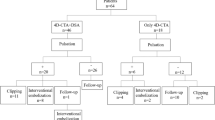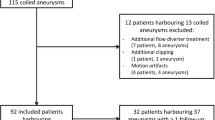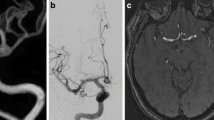Abstract
Recent advances in computed tomography angiography (CTA) enable repeated imaging follow up for post-clipping surgery. The purpose of this study was to clarify the critical volume and configuration of the aneurysmal clip in the postoperative evaluation using volume rendering (VR) imaging, and present four-dimensional (4D)-CTA for these larger metal artifacts. A total of 44 patients with cerebral aneurysm, treated using clipping surgery, were included in this study. The metal artifact volume was assessed using CTA and the association between the type of clips and its metal artifact volume was analyzed. A VR image and a 4D-CTA were then produced, and the diagnostic accuracy of arteries around the clip or residual aneurysm on these images was evaluated. In the receiver operating characteristic (ROC) curve analysis, the cutoff value for metal artifacts was 2.32 mm3 as determined through a VR image. Patients were divided into two groups. Group 1 included patients with a simple and small clip, and group 2 included patients with multiple, large or fenestrated clips. The metal artifact volume was significantly larger in group 2, and the group incorporated the cutoff value. Post-clipping status on the VR image was significantly superior in group 1 compared with group 2. In group 2, the imaging quality of post-clipping status on 4D-CTA was superior in 92.9% of patients. The metal artifact volume was dependent on the number, size, or configuration of the clip used. In group 2, evaluation using a 4D-CTA eliminated the effect of the metal artifacts.




Similar content being viewed by others
References
Brown JH, Lustrin ES, Lev MH, Ogilvy CS, Taveras JM (1999) Reduction of aneurysm clip artifacts on CT angiograms: a technical note. AJNR Am J Neuroradiol 20:694–696
Brown MA, Parish J, Guandique CF, Payner TD, Horner T, Leipzig T, Rupani KV, Kim R, Bohnstedt BN, Cohen-Gadol AA (2017) A long-term study of durability and risk factors for aneurysm recurrence after microsurgical clip ligation. J Neurosurg 126:819–824. https://doi.org/10.3171/2016.2.JNS152059
Choi JH, Park JE, Kim MJ, Kim BS, Shin YS (2016) Aneurysmal neck clipping as the primary treatment option for both ruptured and unruptured middle cerebral artery aneurysms. J Korean Neurosurg Soc 59:269–275. https://doi.org/10.3340/jkns.2016.59.3.269
Connolly ES Jr, Rabinstein AA, Carhuapoma JR, Derdeyn CP, Dion J, Higashida RT, Hoh BL, Kirkness CJ, Naidech AM, Ogilvy CS, Patel AB, Thompson BG, Vespa P (2012) Guidelines for the management of aneurysmal subarachnoid hemorrhage: a guideline for healthcare professionals from the American Heart Association/American Stroke Association. Stroke 43:1711–1737. https://doi.org/10.1161/STR.0b013e3182587839
David CA, Vishteh AG, Spetzler RF, Lemole M, Lawton MT, Partovi S (1999) Late angiographic follow-up review of surgically treated aneurysms. J Neurosurg 91:396–401. https://doi.org/10.3171/jns.1999.91.3.0396
Dolati P, Eichberg D, Wong JH, Goyal M (2015) The utility of dual-energy computed tomographic angiography for the evaluation of brain aneurysms after surgical clipping: a prospective study. World neurosurgery 84:1362–1371. https://doi.org/10.1016/j.wneu.2015.06.027
Fahrendorf DM, Goericke SL, Oezkan N, Breyer T, Hussain S, Sandalcioglu EI, Sure U, Forsting M, Gizewski ER (2011) The value of dual-energy CTA for control of surgically clipped aneurysms. Eur Radiol 21:2193–2201. https://doi.org/10.1007/s00330-011-2147-x
Falk Delgado A, Andersson T, Falk Delgado A (2017) Clinical outcome after surgical clipping or endovascular coiling for cerebral aneurysms: a pragmatic meta-analysis of randomized and non-randomized trials with short- and long-term follow-up. Journal of neurointerventional surgery 9:264–277. https://doi.org/10.1136/neurintsurg-2016-012292
Fifi JT, Meyers PM, Lavine SD, Cox V, Silverberg L, Mangla S, Pile-Spellman J (2009) Complications of modern diagnostic cerebral angiography in an academic medical center. Journal of vascular and interventional radiology : JVIR 20:442–447. https://doi.org/10.1016/j.jvir.2009.01.012
Fotakopoulos G, Tsianaka E, Fountas K, Makris D, Spyrou M, Hernesniemi J (2017) Clipping versus coiling in anterior circulation ruptured intracranial aneurysms: a meta-analysis. World neurosurgery 104:482–488. https://doi.org/10.1016/j.wneu.2017.05.040
Frolich AM, Schrader D, Klotz E, Schramm R, Wasser K, Knauth M, Schramm P (2013) 4D CT angiography more closely defines intracranial thrombus burden than single-phase CT angiography. AJNR Am J Neuroradiol 34:1908–1913. https://doi.org/10.3174/ajnr.A3533
Gerardin E, Tollard E, Derrey S, Langlois O, Dacher JN, Douvrin F, Freger P, Proust F (2010) Usefulness of multislice computerized tomographic angiography in the postoperative evaluation of patients with clipped aneurysms. Acta Neurochir 152:793–802. https://doi.org/10.1007/s00701-009-0465-4
Golitz P, Struffert T, Ganslandt O, Lang S, Knossalla F, Doerfler A (2014) Contrast-enhanced angiographic computed tomography for detection of aneurysm remnants after clipping: a comparison with digital subtraction angiography in 112 clipped aneurysms. Neurosurgery 74:606–613; discussion 613-604. https://doi.org/10.1227/neu.0000000000000326
Golitz P, Struffert T, Ganslandt O, Saake M, Lucking H, Rosch J, Knossalla F, Doerfler A (2012) Optimized angiographic computed tomography with intravenous contrast injection: an alternative to conventional angiography in the follow-up of clipped aneurysms? J Neurosurg 117:29–36. https://doi.org/10.3171/2012.3.jns111895
Gonner F, Lovblad KO, Heid O, Remonda L, Guzman R, Barth A, Schroth G (2002) Magnetic resonance angiography with ultrashort echo times reduces the artefact of aneurysm clips. Neuroradiology 44:755–758. https://doi.org/10.1007/s00234-002-0825-8
Grieve JP, Stacey R, Moore E, Kitchen ND, Jager HR (1999) Artefact on MRA following aneurysm clipping: an in vitro study and prospective comparison with conventional angiography. Neuroradiology 41:680–686
Gruber A, Dorfer C, Standhardt H, Bavinzski G, Knosp E (2011) Prospective comparison of intraoperative vascular monitoring technologies during cerebral aneurysm surgery. Neurosurgery 68:657–673; discussion 673. https://doi.org/10.1227/NEU.0b013e31820777ee
Hashimoto A, Mikami T, Komatsu K, Noshiro S, Hirano T, Wanibuchi M, Mikuni N (2017) Assessment of hemodynamic compromise using computed tomography perfusion in combination with 123I-IMP single-photon emission computed tomography without acetazolamide challenge test. Journal of stroke and cerebrovascular diseases: the official journal of National Stroke Association 26:627–635. https://doi.org/10.1016/j.jstrokecerebrovasdis.2016.11.013
Jabbarli R, Pierscianek D, Wrede K, Dammann P, Schlamann M, Forsting M, Muller O, Sure U (2016) Aneurysm remnant after clipping: the risks and consequences. J Neurosurg 125:1249–1255. https://doi.org/10.3171/2015.10.JNS151536
Kang HS, Han MH, Kwon BJ, Jung SI, Oh CW, Han DH, Chang KH (2004) Postoperative 3D angiography in intracranial aneurysms. AJNR Am J Neuroradiol 25:1463–1469
Kortman HG, Smit EJ, Oei MT, Manniesing R, Prokop M, Meijer FJ (2015) 4D-CTA in neurovascular disease: a review. AJNR Am J Neuroradiol 36:1026–1033. https://doi.org/10.3174/ajnr.A4162
Krisht AF, Gomez J, Partington S (2006) Outcome of surgical clipping of unruptured aneurysms as it compares with a 10-year nonclipping survival period. Neurosurgery 58:207–216; discussion 207-216. https://doi.org/10.1227/01.NEU.0000194638.61073.FC
Le Roux PD, Elliott JP, Eskridge JM, Cohen W, Winn HR (1998) Risks and benefits of diagnostic angiography after aneurysm surgery: a retrospective analysis of 597 studies. Neurosurgery 42:1248–1254; discussion 1254-1245
Lee JH, Kim SJ, Cha J, Kim HJ, Lee DH, Choi CG, Lee HK, Suh DC, Ahn JS (2005) Postoperative multidetector computed tomography angiography after aneurysm clipping: comparison with digital subtraction angiography. J Comput Assist Tomogr 29:20–25
Macdonald RL, Wallace MC, Kestle JR (1993) Role of angiography following aneurysm surgery. J Neurosurg 79:826–832. https://doi.org/10.3171/jns.1993.79.6.0826
Machida H, Tanaka I, Fukui R, Shen Y, Ishikawa T, Tate E, Ueno E (2016) Dual-energy spectral CT: various clinical vascular applications. Radiographics : a review publication of the Radiological Society of North America, Inc 36:1215–1232. https://doi.org/10.1148/rg.2016150185
Mamourian AC, Pluta DJ, Eskey CJ, Merlis AL (2007) Optimizing computed tomography to reduce artifacts from titanium aneurysm clips: an in vitro study. Technical note. J Neurosurg 107:1238–1243. https://doi.org/10.3171/JNS-07/12/1238
Manninen AL, Isokangas JM, Karttunen A, Siniluoto T, Nieminen MT (2012) A comparison of radiation exposure between diagnostic CTA and DSA examinations of cerebral and cervicocerebral vessels. AJNR Am J Neuroradiol 33:2038–2042. https://doi.org/10.3174/ajnr.A3123
Murphy M, Bell D, Worth RD, Jehle KS, Critchley GR, Norris JS (2005) Angiography postclipping and coiling of cerebral aneurysms. Br J Neurosurg 19:225–228. https://doi.org/10.1080/02688690500202067
Nagatani T, Shibuya M, Ooka K, Suzuki Y, Takayasu M, Yoshida J (1998) Titanium aneurysm clips: mechanical characteristics and clinical trial. Neurol Med Chir 38(Suppl):39–44
Nakamura Y, Kohmura E (2005) Outcome of surgical clipping for ruptured, low-grade, anterior circulation cerebral aneurysms: should clipping be omitted after International Subarachnoid Aneurysm Trial? Surg Neurol 64:504–509, discussion 509-510. https://doi.org/10.1016/j.surneu.2005.03.040
Pechlivanis I, Koenen D, Engelhardt M, Scholz M, Koenig M, Heuser L, Harders A, Schmieder K (2008) Computed tomographic angiography in the evaluation of clip placement for intracranial aneurysm. Acta Neurochir 150:669–676. https://doi.org/10.1007/s00701-008-1515-z
Rauzzino MJ, Quinn CM, Fisher WS 3rd (1998) Angiography after aneurysm surgery: indications for “selective” angiography. Surg Neurol 49:32–40 discussion 40-31
Sagara Y, Kiyosue H, Hori Y, Sainoo M, Nagatomi H, Mori H (2005) Limitations of three-dimensional reconstructed computerized tomography angiography after clip placement for intracranial aneurysms. J Neurosurg 103:656–661. https://doi.org/10.3171/jns.2005.103.4.0656
Spiotta AM, Hui F, Schuette A, Moskowitz SI (2013) Patterns of aneurysm recurrence after microsurgical clip obliteration. Neurosurgery 72:65–69; discussion 69. https://doi.org/10.1227/NEU.0b013e318276b46b
Thompson BG, Brown RD, Jr., Amin-Hanjani S, Broderick JP, Cockroft KM, Connolly ES, Jr., Duckwiler GR, Harris CC, Howard VJ, Johnston SC, Meyers PM, Molyneux A, Ogilvy CS, Ringer AJ, Torner J (2015) Guidelines for the management of patients with unruptured intracranial aneurysms: a guideline for healthcare professionals from the American Heart Association/American Stroke Association. Stroke 46:2368–2400. doi:https://doi.org/10.1161/str.0000000000000070
Thornton J, Bashir Q, Aletich VA, Debrun GM, Ausman JI, Charbel FT (2000) What percentage of surgically clipped intracranial aneurysms have residual necks? Neurosurgery 46:1294–1298; discussion 1298-1300
Uysal E, Ozel A, Erturk SM, Kirdar O, Basak M (2009) Comparison of multislice computed tomography angiography and digital subtraction angiography in the detection of residual or recurrent aneurysm after surgical clipping with titanium clips. Acta Neurochir 151:131–135. https://doi.org/10.1007/s00701-009-0184-x
van der Schaaf I, van Leeuwen M, Vlassenbroek A, Velthuis B (2006) Minimizing clip artifacts in multi CT angiography of clipped patients. AJNR Am J Neuroradiol 27:60–66
Willems PW, Taeshineetanakul P, Schenk B, Brouwer PA, Terbrugge KG, Krings T (2012) The use of 4D-CTA in the diagnostic work-up of brain arteriovenous malformations. Neuroradiology 54:123–131. https://doi.org/10.1007/s00234-011-0864-0
Willinsky RA, Taylor SM, TerBrugge K, Farb RI, Tomlinson G, Montanera W (2003) Neurologic complications of cerebral angiography: prospective analysis of 2,899 procedures and review of the literature. Radiology 227:522–528. https://doi.org/10.1148/radiol.2272012071
Yu L, Leng S, McCollough CH (2012) Dual-energy CT-based monochromatic imaging. AJR Am J Roentgenol 199:S9–s15. https://doi.org/10.2214/ajr.12.9121
Zachenhofer I, Cejna M, Schuster A, Donat M, Roessler K (2010) Image quality and artefact generation post-cerebral aneurysm clipping using a 64-row multislice computer tomography angiography (MSCTA) technology: a retrospective study and review of the literature. Clin Neurol Neurosurg 112:386–391. https://doi.org/10.1016/j.clineuro.2010.02.001
Author information
Authors and Affiliations
Corresponding author
Ethics declarations
Conflict of interest
The authors declare that they have no conflicts of interest.
Electronic supplementary material
ESM 1
(MP4 4259 kb)
Rights and permissions
About this article
Cite this article
Kimura, Y., Mikami, T., Miyata, K. et al. Vascular assessment after clipping surgery using four-dimensional CT angiography. Neurosurg Rev 42, 107–114 (2019). https://doi.org/10.1007/s10143-018-0962-0
Received:
Revised:
Accepted:
Published:
Issue Date:
DOI: https://doi.org/10.1007/s10143-018-0962-0




